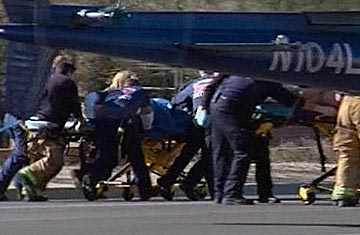
A medical helicopter evacuates victims from an event in Tucson, Ariz., where 19 people were shot and U.S. Representative Gabrielle Giffords was seriously wounded.
Updated: 12:25 a.m.
Sometimes, rumors of violence beget actual violence. Saturday's mass shooting at a Safeway on North Oracle Road in Tucson, which killed six and left Democratic Congresswoman Gabrielle Giffords and others gravely wounded, may well be one of those occasions.
It's impossible to know this early what the motivations for the attack were. Was the alleged shooter — who has been identified as 22-year-old Tucsonan Jared Loughner — angry about immigration? Or perhaps another hot-button issue? YouTube videos ascribed to him bore the mark of mental illness — they were conspiratorial, unintelligible, espousing no particular cause — but no matter his mental state, his crime took place in an overheated political environment. Last March, at the height of the health care reform battle, Giffords' office was vandalized. She mentioned in an MSNBC interview that a Sarah Palin graphic had depicted her district in the crosshair of a gun sight. "They've got to realize there are consequences to that," she said. "The rhetoric is incredibly heated." The corner next to her office had also become, she said, a popular spot for Tea Party protests.
As Pima County Sheriff Clarence Dupnik put it in an extraordinary and melancholic press conference after the shooting, "we have become the Mecca for prejudice and bigotry." He added that he's "not aware of any public officials who are not receiving threats."
Another shooting victim, a federal judge named John Roll, had been placed under 24-hour security in 2009 after ruling in favor of illegal immigrants in a high-profile case. It's unclear why he was at the supermarket event. But for almost a year now, Arizona's leaders have been grappling with anti-immigration sentiments, inflamed by reports of crossborder violence. National media attention, with its attendant voices of hysteria, only added to the churn. Pundits spoke gravely about a wave of violence, born in Mexico and now flooding Arizona. Arizona's two most famous politicians fueled the fury. Republican Senator John McCain, facing an unexpected reelection challenge from the right, ran a campaign obsessed with crossborder crime. And GOP Governor Jan Brewer, who invited the national spotlight by championing strict anti-illegal immigrant legislation, talked of beheadings in the desert.
The only problem with all this talk about a massive crossborder crime wave is that it wasn't true. Phoenix had not become one of the world's kidnapping capitals. Crime rates in Arizona had been steady or even fallen in some areas. There had been no beheadings in the desert. There were plenty of deaths there, but they were pathetic and meek tragedies: impoverished border-crossers, abandoned by their heartless guides, dying of exposure and dehydration.
But the idea of a state under siege took hold. When I was on the border last year reporting on the murder of rancher Rob Krentz, I talked to many who sincerely believed that they were under attack. Krentz's murder was a terrible event, but it was an isolated event. The relatively small number of home invasions, holdups and other crimes deeply disturbed border communities, but only because they had been living in such calm for so long. Their crime rates still don't match most cities in the states.
The supermarket meet-and-greet where Giffords was shot was actually a testimony to just how safe southern Arizona is. As a press release from her office last week put it, "'Congress on Your Corner' allows residents of Arizona's 8th Congressional District to meet their congresswoman one-on-one and discuss with her any issue, concern or problem involving the federal government." Not exactly the kind of event a politician would hold in a war zone.
It's true that Giffords was not a fan of the state's anti-immigration bill SB1070, but there were higher-profile opponents, such as her fellow Congressional Representative in Tuscon, Raul Grijalva. Yet the idea that Arizona is under attack has been pushed hard enough that it's very possible that the coward who shot her (in the head, according to a Tucson paper) believed that the 40-year-old Democrat, who had been tarred by some as soft on immigration because she didn't support SB1070, was contributing to larger-scale violence against Arizonans.
If that is the case, it would only add to the tragedy. The fact is, that among all the overwrought promises and all the panic I heard last summer in Arizona, I found that Giffords was one of the few politicians offering concrete law enforcement steps that would actually work against the drug cartels and other smugglers. It's not just that she fought for more money and police for border protection, although she did that. She co-sponsored legislation last year with a California Republican that aimed to give law enforcement important new tools in cracking down on the cash cards that were a favored methods of money-laundering. It was one of the many sensible, pragmatic ideas she had for cracking down on crime.
Whatever dark fantasies drove someone to try to take her life, Giffords is a sensible politician who was likely shot because she dealt with Arizona's reality, not its rumors.
